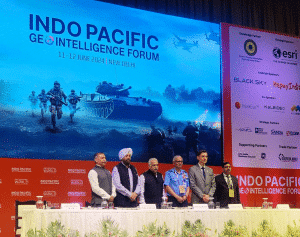What should we expect from the regulatory bodies governing GPS/GNSS technologies? Where do we see the greatest threats to GNSS accuracy and safety, and what is the industry doing about them?? These are just some of the questions facing equipment manufacturers, integrators, and others developing position, navigation, and timing (PNT) technologies as they look ahead in the coming year.
As the world’s leading provider of PNT testing solutions for nearly four decades, we’re well positioned to offer some answers. Based on hundreds of engagements we’re conducting worldwide, here are the biggest PNT trends we’re following in 2025.
NAVWAR threats will grow beyond the battlefield, increasingly disrupting civil applications
Targeting an adversary’s signals has been a longstanding tactic in military conflicts. No surprise then that in recent decades, militaries have had to contend with growing navigation warfare (NAVWAR) attacks seeking to disrupt GPS/GNSS-dependent vehicles and aircraft, especially uncrewed aircraft systems (UAS). What has been surprising, however, is just how much these threats have come to affect civil applications too.
In vast regions of airspace around Ukraine, the Middle East, and other areas of conflict, commercial aircraft are increasingly subject to NAVWAR attacks. These include techniques that jam PNT signals, or worse, spoof them so that GPS/GNSS receivers appear to be functioning normally, but are using incorrect GNSS data. Such attacks increase the risk of a catastrophic accident like a collision, of course, but given how many systems in commercial airliners now depend on GNSS, they create many other safety and efficiency problems too. Air crews may need to operate without longstanding automation and safety systems, such as terrain and ground proximity warning systems. Ground crews may need to reroute affected aircraft or clear airspace around them, disrupting other flights and crews, and increasing fuel consumption.
These issues were rare in the past, but no longer. One industry analysis found a 400% increase in the number of affected flights in the first six months of 2024. We now regularly track more than 1,300 flights affected per day. And the threat increasingly extends beyond aviation. As more of the world’s economy and critical infrastructure relies on accurate PNT information, GNSS jamming and spoofing now disrupts a broad range of “business-critical” use cases too, from financial systems to energy grids to search and rescue applications. The good news: this year, the industry is beginning to mount a coordinated response.
Commercial aviation groups, along with stakeholders across the PNT ecosystem, are coming together to promote more robust and resilient PNT systems that can better withstand jamming and spoofing. These efforts include evaluating the suitability of both planned and existing technologies such as controlled reception pattern antennas (CRPAs), secure and authenticated signals, dual-frequency GNSS systems, and others. As this longer-term work proceeds, some companies also now offer GNSS spoofing alerting services to help mitigate the immediate threat. These integrate with pilots’ existing electronic flight bags and ground-based systems, issuing alerts when an aircraft approaches a region with current spoofing activity, similar to alerts for extreme weather.
Developers will make more use of GNSS receiver data to combat new threats
As the PNT ecosystem seeks to improve GNSS system resiliency to spoofing, we will be evaluating a wide range of interventions. There may be, however, some low-hanging fruit within many existing GNSS receivers, that developers and integrators can start taking advantage of right away. Modern GNSS chipsets are highly sophisticated, and in many cases, provide much more data that could be used to detect spoofing attacks, that system developers have not previously needed to tap into. This year, look for more developers and integrators to start exploiting this data.
These efforts could entail reading additional GNSS chipset data into their systems and wrapping new algorithms around them to detect when reported PNT information looks off. For example, a system could detect that a received signal is much stronger than it should be given the angle of elevation of the satellite supposedly transmitting it. By drawing on more GNSS data and applying this type of logic, integrators could provide immediate resiliency improvements to some GNSS receivers, without having to add new hardware.
Prepare for new regulation around PNT performance
The PNT space is not new to regulatory oversight; the industry has long worked with regulations like Radio Equipment Directive, eCall, ERA-GLONASS, and others. This year, however, we expect a new regulatory regime to emerge around optimized PNT performance standards for key industries and technologies. Indeed, if there is a common theme for our 2025 predictions so far, it’s the recognition that GNSS technology has become core to a diverse, growing body of critical systems and applications.
China, for example, has instituted standards (GB/T) defining PNT performance requirements for the automotive industry. Based on exploratory activity we’re seeing, similar efforts will likely emerge in other markets and industries in the coming months. We also anticipate efforts to broaden existing standards, such as RTCA DO-229, to protect against evolving PNT threats like spoofing, which now affect a growing body of applications from commercial drones to consumer electronics.
PNT developers will “shift left” in testing
One of the more interesting trends we’re following is unfolding within the PNT technology sector itself, as the industry expands the use of model-based system engineering in product development. Those outside the industry may not appreciate how transformative this is. But for those developing GNSS receivers, who have to test a large and growing range of scenarios in lifelike PNT operating environments, the ability to accomplish more in software, rather than exclusively via hardware testing, is a significant and welcome change.
Whether GNSS is deployed in a vehicle navigation system, a consumer electronic device, or any other product, developers must contend with a huge number of potential issues that could affect system performance. And as GNSS becomes a key technology in more products, the range of scenarios to test keeps growing. Now, by using highly accurate system models and ultra-realistic simulations of operating environments, developers can “shift left”, exploring more questions earlier in the development cycle. As a result, they can run thousands of test scenarios in parallel and accelerate development timelines—a huge benefit in this fast-moving space. They can improve quality by exploring rarer scenarios and corner cases, at a much lower cost. And they can identify problems earlier, long before physical manufacturing begins.








